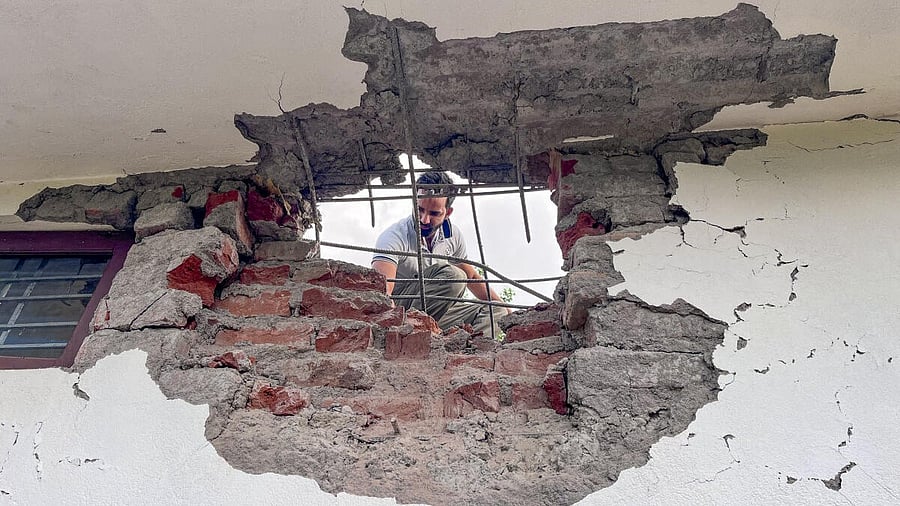
A man looks through a damaged portion of a house after heavy firing and shelling by Pakistan military overnight across the Line of Control and International Border, at Mendhar area of Poonch district, Jammu and Kashmir, Wednesday, May 7, 2025. At least three civilians were killed and ten injured in the incident, according to officials.
Credit: PTI Photo
The India-Pakistan conflict, in the aftermath of the April 22 Pahalgam terror attack, which ended in a ceasefire on May 11, was the most intense in a few decades. Multiple harms were suffered by the civilian population in the border states, primarily in Jammu & Kashmir, Punjab, and Rajasthan, and also Haryana.
Some noticeable firsts have occurred in this conflict:
Expansion of conflict to urban centres: This was the first conflict in decades to have impacted large, heavily populated cities, like Jammu and Chandigarh. The challenges of protecting populations in urban centres from conflict are immense.
In contemporary conflicts, 90% of casualties in urban areas are civilians. There is also damage to critical infrastructure like water tanks or health posts, catastrophic for a service-dependent urban population. Conflict also negatively impacts the many livelihoods and education opportunities on offer.
First conflict deployment of unmanned aerial vehicles (UAVs or drones): This conflict involved the first use of explosive weapons drones, and surveillance drones. Their growing use in conflict and risk of death and injuries to civilians from these have been documented in Ukraine, in Gaza (and elsewhere in West Asia) and across Africa.
Drones are also a source of psychological stress on civilians and impact their everyday lives. Moreover, Geneva Call notes that, kinetic weapons like missiles, rockets or other drones used to shoot down drones may also pose a threat to civilians in their vicinity.
Rise in disinformation and misinformation: One of the most reported concerns in this conflict was the rise in misinformation, and disinformation. For civilians in conflict, not only is this a source of additional stress, but it could also hamper government messaging efforts to keep people safe.
The civilian harms to people in border states include 22 civilian deaths and an unknown number of injured. In J&K, displacement of thousands of families along the line of control (LOC) was reported (in addition to those evacuated there and in Punjab). In some cases, families noted they should have been warned of potential shelling earlier and given time to move to safety.
The harm of displacement due to the sheer number of people having to leave their homes, is the most significant harm in this conflict. Others who chose to stay rather than flee, did not always find adequate bomb shelters for protection. Destruction of civilian property, homes, and shops was reported from J&K. Reports noted unexploded ordinance debris in Punjab, Rajasthan, and Haryana. Till date there is no release of official government data on these various harms and number of civilians impacted.
Measures to protect civilians in the next conflict
The best yet elusive measure to protect civilians did occur in this conflict — a ceasefire. Which immediately translates into lives saved and other harms ending. Nevertheless, other measures to protect civilians can be taken prior to, during, and after a conflict. A few suggestions are:
Robust contingency planning: In this conflict, commendable efforts were made by various authorities and local communities themselves, to get people to safety and to ensure government messaging reached all locations in the border states. Upon declaration of the ceasefire, ordinance debris clearance has commenced in various locations, and people are returning to their homes (although some are still fearful to return). In J&K, damage assessment of property has commenced to provide compensation to affected civilians.
Nonetheless, there is a need for robust contingency planning for any future conflict. This shift in locations and populations impacted should be examined, and it may require planning for increased displacement sites, bomb shelters and efficient property destruction compensation schemes. In addition, there should be specific planning for urban centres: with measures to address misinformation/disinformation, awareness of unexploded ordinances, etc., on scale and provisioning for adequate bomb shelters and continuity of essential services. The authorities should also explore psycho-social counselling support for a conflict-impacted population.
Regulation of drone warfare: While there is an increasing use of drones in warfare, their targeting is not always accurate and civilians are killed. The Indian government should actively participate in deliberations to minimise the harmful impact on civilians in conflict zones, in line with international law. While there is no global agreement on the regulation of drones, one step India could take is to sign the non-binding Declaration on Explosive Weapons and also support the regulation of AI weapons.
Sharing data on civilian harm to public: Civilian harm data is used by governments to highlight violations of international law by their adversary (as seen in the joint ministry of defence and external affairs briefings). This data could help armed forces with operations planning.
In addition, it is imperative that appropriate sharing of this data to the public occur, for multiple reasons. First, it reflects transparency and accountability. Second, it leaves no room for misinformation/disinformation. Third, such data could help increase the empathy of other Indians with the border states.
Protecting civilians sits easily with India’s democratic rights-centred Constitution and its explicit commitment to upholding the international rules-based order by being party to treaties such as, the 1949 Geneva Conventions. These contain international humanitarian law, which applies even if the other party to the conflict may not adhere to it. It’s a moral high ground India could claim.
(Sarah Khan is a former UN Civil Servant who consults on law and policy to protect civilians and displacement in violent settings. X: @Khan2005Sarah.)
Disclaimer: The views expressed above are the author's own. They do not necessarily reflect the views of DH.